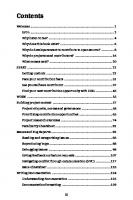Program Management for Open Source Projects: How to Guide Your Community-Driven, Open Source Project 9781680509243
Every organization develops a bureaucracy, and open source projects are no exception. When your structure is intentional
147 28 2MB
English Pages 192 Year 2022
Table of contents :
Acknowledgments
Introduction
What a Program Manager Does
Why Program Management Is Important
Why You Want This Book
1. Manage the Program
Take the Big Picture View
Balance Priorities
Manage Risks
Report Status
Do Everything
Manage Single Points of Failure and Burnout
Retrospective
2. Zoom in on Projects
Define “Project”
Find the Balance
Know the Artifacts
Retrospective
3. Communicate and Build Relationships
Build Relationships
Communicate
Retrospective
4. Make Good Decisions
Define the Question
Give a Voice
Take a Vote
Retrospective
5. Design Suitable Processes
Define the Context
Build a Process
Implement the Process
Make Revisions
Retrospective
6. Hold Useful Meetings
Why Bother?
Schedule the Meeting
Choose the Medium
Make Your Meeting Productive
Make Decisions in the Right Place
Retrospective
7. Develop Your Release Life Cycle
Decide How Many
Set the Phases
Set the Length
Retrospective
8. Build a Release Schedule
A Schedule’s Purpose
Choose a Schedule Model
Define "Done"
Add Milestones
Manage Conflicts
Keep the Schedule Accurate
Communicate the Schedule
Retrospective
9. Manage Features
Create a Template
Set the Scale
Set the Approval Process
Create the Timeline
Define the Life Cycle of a Proposal
Shepherd the Proposals
Retrospective
10. Track and Triage Bugs
Track Bugs
Triage Bugs
Prioritize Bugs
Close Bugs
Analyze Bugs
Retrospective
11. Ship the Release
Set Release Criteria
Freeze the Code
Produce Release Candidates
Determine Readiness
Make the Decision
Retrospective
A1. Choose Your Tools
Identify Your Requirements
Pick Your Tools
Retrospective
Bibliography
Acknowledgments
Introduction
What a Program Manager Does
Why Program Management Is Important
Why You Want This Book
1. Manage the Program
Take the Big Picture View
Balance Priorities
Manage Risks
Report Status
Do Everything
Manage Single Points of Failure and Burnout
Retrospective
2. Zoom in on Projects
Define “Project”
Find the Balance
Know the Artifacts
Retrospective
3. Communicate and Build Relationships
Build Relationships
Communicate
Retrospective
4. Make Good Decisions
Define the Question
Give a Voice
Take a Vote
Retrospective
5. Design Suitable Processes
Define the Context
Build a Process
Implement the Process
Make Revisions
Retrospective
6. Hold Useful Meetings
Why Bother?
Schedule the Meeting
Choose the Medium
Make Your Meeting Productive
Make Decisions in the Right Place
Retrospective
7. Develop Your Release Life Cycle
Decide How Many
Set the Phases
Set the Length
Retrospective
8. Build a Release Schedule
A Schedule’s Purpose
Choose a Schedule Model
Define "Done"
Add Milestones
Manage Conflicts
Keep the Schedule Accurate
Communicate the Schedule
Retrospective
9. Manage Features
Create a Template
Set the Scale
Set the Approval Process
Create the Timeline
Define the Life Cycle of a Proposal
Shepherd the Proposals
Retrospective
10. Track and Triage Bugs
Track Bugs
Triage Bugs
Prioritize Bugs
Close Bugs
Analyze Bugs
Retrospective
11. Ship the Release
Set Release Criteria
Freeze the Code
Produce Release Candidates
Determine Readiness
Make the Decision
Retrospective
A1. Choose Your Tools
Identify Your Requirements
Pick Your Tools
Retrospective
Bibliography

![Program Management for Open Source Projects: How to Guide Your Community-Driven, Open Source Project [1 ed.]
1680509241, 9781680509243](https://ebin.pub/img/200x200/program-management-for-open-source-projects-how-to-guide-your-community-driven-open-source-project-1nbsped-1680509241-9781680509243.jpg)


![Open source for business a practical guide to open source software licensing [Third ed.]
2015906061](https://ebin.pub/img/200x200/open-source-for-business-a-practical-guide-to-open-source-software-licensing-thirdnbsped-2015906061.jpg)





